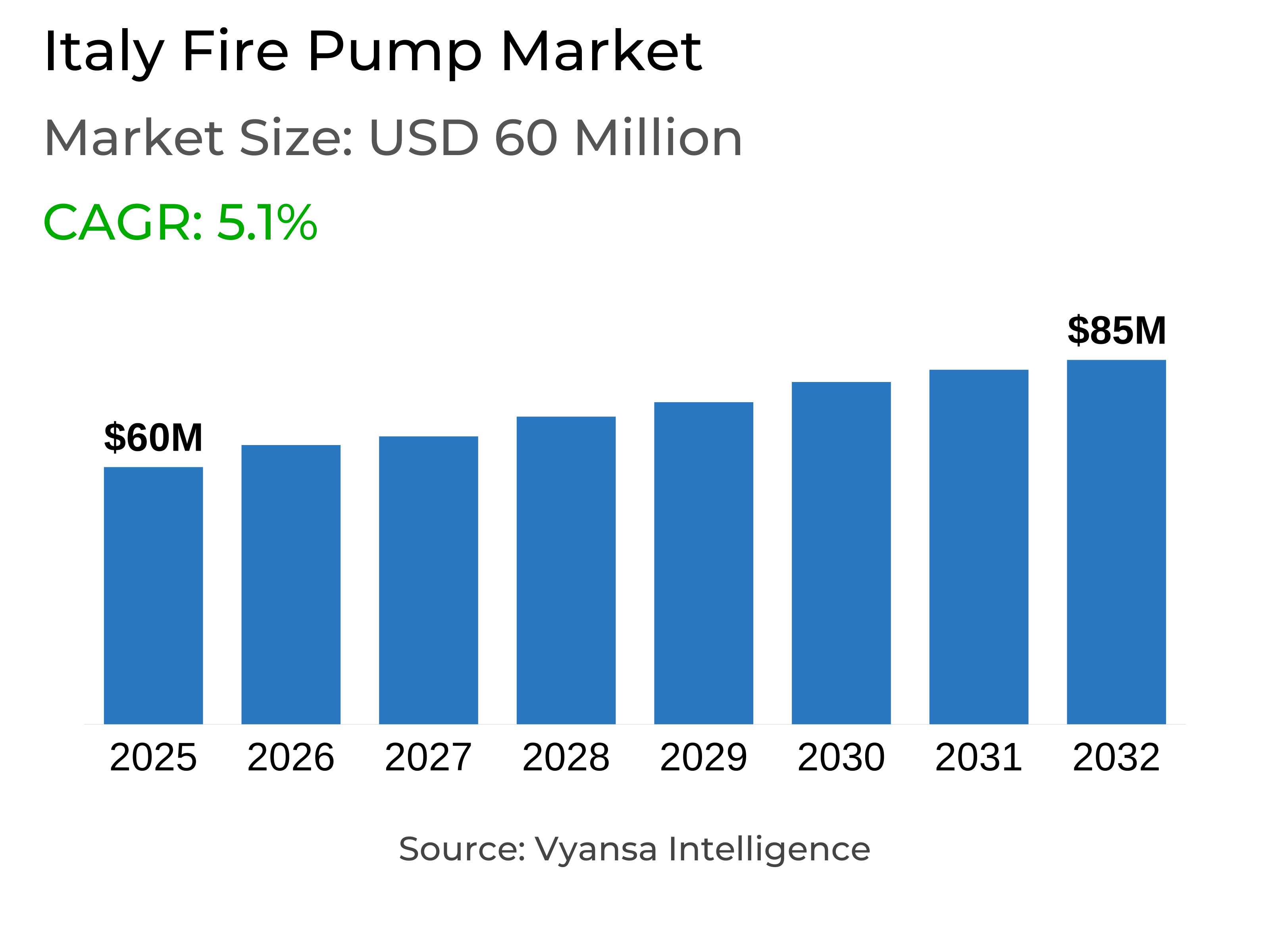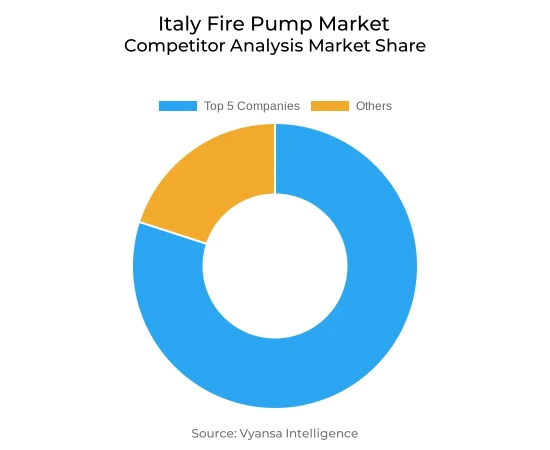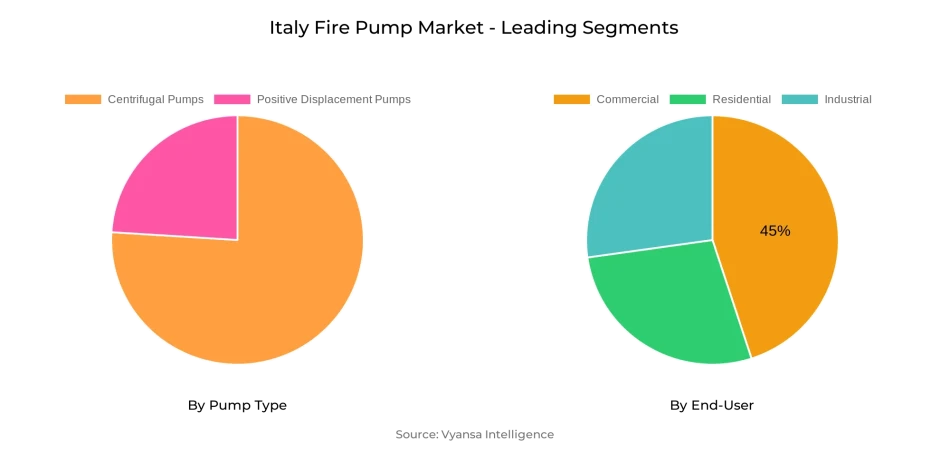
Italy Fire Pump Market Report: Trends, Growth and Forecast (2026-2032)
By Pump Type (Centrifugal Pumps (Overhung Pumps, Vertical Inline, Horizontal End Suction), Split Case Pumps (Single/Two Stage, Multi Stage)), Positive Displacement Pumps (Diaphragm Pumps, Piston Pumps), By Mode of Operation (Diesel Fire Pump, Electric Fire Pump, Others), By End-User (Residential, Commercial, Industrial)
- Energy & Power
- Oct 2025
- VI0504
- 125
-




Italy Fire Pump Market Statistics and Insights, 2026
- Market Size Statistics
- Fire Pump in Italy is estimated at $ 60 Million.
- The market size is expected to grow to $ 85 Million by 2032.
- Market to register a CAGR of around 5.1% during 2026-32.
- Pump Type Segment
- Centrifugal Pumps continues to dominate the market.
- Competition
- More than 10 companies are actively engaged in producing Fire Pump in Italy.
- Top 5 companies acquired the maximum share of the market.
- WILO SE, Ebara Corporation, ITT Goulds Pumps, Flowserve Corporation, Pentair PLC etc., are few of the top companies.
- End-User
- Commercial grabbed 45% of the market.
Italy Fire Pump Market Outlook
The Italy Fire Pump Market, which stands at USD 60 million in 2025, is projected to develop steadily and hit around USD 85 million by 2032. This growth is in accordance with increasing fire safety demands throughout the nation, as the National Fire Corps continues to document hundreds of thousands of fire and explosion interventions every year. Such intense operational activity is what indicates the need for hardy, high-pressure pumps that can endure extended use without frequent downtime.
One of the most significant challenges in Italy is its outdated infrastructure, with almost three-quarters of buildings built prior to contemporary fire safety codes. Retrofitting older buildings calls for compact and flexible pumping systems, especially in old residential areas where 24.2% of fires take place. Suppliers are responding to this demand with modular centrifugal pumps that occupy limited space without sacrificing efficiency, which enables older and heritage buildings to fulfill today's standards of safety.
Smart pumping technologies are also defining the market landscape. IoT-equipped pumps with remote monitoring, predictive maintenance, and energy-efficient motor designs are assisting fire departments in minimizing unexpected failures and managing operating expenses. These technologies align with overall EU sustainability objectives as well as offer useful benefits to pressure-conscious firefighting agencies.
Among end-users, the commercial segment leads, with 45% of the market, led by office, retail, and hotel building demand. But the residential category is forecast to increase most rapidly, at a rate of 5.7% CAGR, as housing renewal and fire protection consciousness spread throughout the country. Combined, these forces deliver a balanced market scenario in which both new-age technologies and retrofitting solutions will fuel uniform market growth to 2032.

Italy Fire Pump Market Growth Driver
Rising Fire Incidence and Urban Demands
Italy fire incidents remain a driving force behind the demands for strong firefighting equipment, with the National Fire Corps reporting 231,000 interventions for explosions and fires between July 2019 and August 2020. The high level of operations emphasizes the need for stable, high-pressure pumps that can withstand prolonged periods of continuous operation without breakdown. Urban density also increases the requirements for equipment that is rapidly deployable and should be easily serviced to provide effective response in risky conditions.
Compounding this urgency is the nation's aging infrastructure, where almost 75% of buildings were constructed prior to the implementation of contemporary fire safety codes. Many of these older buildings have inefficient water supply systems and non-standard installations, making firefighting more difficult. The upgrade of pump technology and infrastructure within such environments is important to improving safety results and limiting operation downtime.
Italy Fire Pump Market Challenge
Equipment Reliability and Infrastructure Constraints
Italy also grapples with growing pressures as firefighting forces struggle with increasing operational requirements with traditional infrastructures. With the number of annual fire interventions crossing a quarter million cases, current pump fleets are subject to increased wear and tear, causing recurrent breakdowns and unscheduled maintenance. This pressure not only drives up operational expenses but also undermines reliability at the very moments when speed is most critical. Maintaining durability and reducing downtime have thus become key concerns for the entire national firefighting network.
Retrofitting historic buildings adds an extra level of complexity, with non-conventional floor plans and limited space demanding flexible pumping equipment. Most significantly, 24.2% of all fires are reported in residential spaces, most of which are located in historic neighborhoods with minimal infrastructure. Creating pumps that are compatible with such spaces, while ensuring efficiency, is a priority challenge for manufacturers and service providers who want to enhance country-wide fire readiness.
Italy Fire Pump Market Trend
Adoption of Smart and Efficient Technologies
The Italy Fire Pump Market is experiencing significant developments in intelligent pumping solutions, as IoT-based systems are emerging as popular choices. Such pumps comprise remote diagnostics, predictive maintenance, and automated pressure regulation, allowing real-time monitoring of system performance. These features minimize unplanned failures, optimize service scheduling, and contribute substantially to overall operational readiness for fire departments working under constant pressure.
Efficiency is also becoming a leading theme, with producers emphasizing sophisticated motor design that minimizes fuel use during extended operation. The breakthroughs not only save operating costs for fire departments but are also conducive to wider sustainability goals at the national and EU levels. As information from networked pumps mounts, the sector will further optimize product performance and speed the move toward advanced technologies in firefighting systems.
Italy Fire Pump Market Opportunity
Expanding Retrofit and Deployment Opportunities
Italy's extensive heritage and pre-modern building base poses a strong potential for retrofitting solutions specific to older infrastructure. Centrifugal pumps that are designed to be installed compactly and are in high demand, as they allow for upgrading with little structural alteration. These solutions are of special interest in older urban areas, where architectural integrity must be upheld in addition to providing current safety standards. This niche market presents consistent growth potential for producers that provide specialized designs.
Simultaneously, wider deployment opportunities are arising in wildfire-risk areas, where partnerships with civil protection bodies are driving adoption of mobile pump units. Fitted with quick-connection couplings, these highly adaptable systems address both urban and rural applications, reaching new markets. By tailoring pump packages to separate regional needs—varying from downtown districts to extensive forest areas—companies are positioned strongly to expand into new market segments and deliver long-term, sustainable growth.
Italy Fire Pump Market Segmentation Analysis

By Pump Type
- Centrifugal Pumps
- Positive Displacement Pumps
In Pump Type category, "Centrifugal Pumps" maintain the highest market share in Italy Fire Pump Market. Due to their straightforward design, high outflow rate, and low maintenance needs, they have become the most universally accepted choice on a wide range of applications. The pumps establish constant water pressure apt for dense urban areas as well as rural wildfire situations, emphasizing their generalizability for varied firefighting conditions.
Producers are also upgrading centrifugal pump performance with corrosion-proof materials and module-based part designs that facilitate quick replacements. Multi-stage impeller models are also becoming popular because they increase water pressure without taking up additional space. With their established longevity and productivity, centrifugal pumps are still the central technology behind Italy's contemporary firefighting tactics and will continue to have hegemony in the market.
By End-User
- Residential
- Commercial
- Industrial
Commercial use dominates the Italy Fire Pump Market by End-User, with 45% of all installations. Office facilities, shopping centers, and hotels demand integrated systems linked to central water sources, creating steady demand for sophisticated centrifugal designs. The commercial market's high density in urban areas also supports its leadership role, considering that intensive fire protection measures must be applied to such buildings.
Concurrently, the household segment is on track to become the fastest-growing segment, growing at a 5.7% CAGR. Growing investment in multi-family apartment complexes and renovation schemes is driving demand for smaller, simpler-to-install pumps that are suited to reduced spaces. Growing sensitivity among homeowners and property builders towards fire safety codes is likely to ensure residential installations continue on the upswing, presenting new avenues of opportunity for manufacturers as well as service providers.
Top Companies in Italy Fire Pump Market
The top companies operating in the market include WILO SE, Ebara Corporation, ITT Goulds Pumps, Flowserve Corporation, Pentair PLC, Sulzer Limited, Grundfos Holding A/S, KSB SE & Co. KGaA, Patterson (Gorman Rupp), Armstrong, etc., are the top players operating in the Italy Fire Pump Market.
Frequently Asked Questions
Related Report
1. Market Segmentation
1.1. Research Scope
1.2. Research Methodology
1.3. Definitions and Assumptions
2. Executive Summary
3. Italy Fire Pump Market Policies, Regulations, and Standards
4. Italy Fire Pump Market Dynamics
4.1. Growth Factors
4.2. Challenges
4.3. Trends
4.4. Opportunities
5. Italy Fire Pump Market Statistics, 2022-2032F
5.1. Market Size & Growth Outlook
5.1.1.By Revenues in US$ Million
5.2. Market Segmentation & Growth Outlook
5.2.1.By Pump Type
5.2.1.1. Centrifugal Pumps- Market Insights and Forecast 2022-2032, USD Million
5.2.1.1.1.1. Overhung Pumps- Market Insights and Forecast 2022-2032, USD Million
5.2.1.1.1.2. Vertical Inline- Market Insights and Forecast 2022-2032, USD Million
5.2.1.1.1.3. Horizontal End Suction- Market Insights and Forecast 2022-2032, USD Million
5.2.1.1.2. Split Case Pumps- Market Insights and Forecast 2022-2032, USD Million
5.2.1.1.2.1. Single/Two Stage- Market Insights and Forecast 2022-2032, USD Million
5.2.1.1.2.2. Multi Stage- Market Insights and Forecast 2022-2032, USD Million
5.2.1.2. Positive Displacement Pumps- Market Insights and Forecast 2022-2032, USD Million
5.2.1.2.1. Diaphragm Pumps- Market Insights and Forecast 2022-2032, USD Million
5.2.1.2.2. Piston Pumps - Market Insights and Forecast 2022-2032, USD Million
5.2.2.By Mode of Operation
5.2.2.1. Diesel Fire Pump- Market Insights and Forecast 2022-2032, USD Million
5.2.2.2. Electric Fire Pump- Market Insights and Forecast 2022-2032, USD Million
5.2.2.3. Others- Market Insights and Forecast 2022-2032, USD Million
5.2.3.By End-User
5.2.3.1. Residential- Market Insights and Forecast 2022-2032, USD Million
5.2.3.2. Commercial- Market Insights and Forecast 2022-2032, USD Million
5.2.3.3. Industrial- Market Insights and Forecast 2022-2032, USD Million
5.2.4.By Competitors
5.2.4.1. Competition Characteristics
5.2.4.2. Market Share & Analysis
6. Italy Centrifugal Fire Pump Market Statistics, 2020-2030F
6.1. Market Size & Growth Outlook
6.1.1.By Revenues in US$ Million
6.2. Market Segmentation & Growth Outlook
6.2.1.By Pump Type- Market Insights and Forecast 2022-2032, USD Million
6.2.2.By Mode of Operation- Market Insights and Forecast 2022-2032, USD Million
6.2.3.By End-User- Market Insights and Forecast 2022-2032, USD Million
7. Italy Positive Displacement Fire Pump Market Statistics, 2020-2030F
7.1. Market Size & Growth Outlook
7.1.1.By Revenues in US$ Million
7.2. Market Segmentation & Growth Outlook
7.2.1.By Pump Type- Market Insights and Forecast 2022-2032, USD Million
7.2.2.By Mode of Operation- Market Insights and Forecast 2022-2032, USD Million
7.2.3.By End-User- Market Insights and Forecast 2022-2032, USD Million
8. Competitive Outlook
8.1. Company Profiles
8.1.1.Flowserve Corporation
8.1.1.1. Business Description
8.1.1.2. Product Portfolio
8.1.1.3. Collaborations & Alliances
8.1.1.4. Recent Developments
8.1.1.5. Financial Details
8.1.1.6. Others
8.1.2.Pentair PLC
8.1.2.1. Business Description
8.1.2.2. Product Portfolio
8.1.2.3. Collaborations & Alliances
8.1.2.4. Recent Developments
8.1.2.5. Financial Details
8.1.2.6. Others
8.1.3.Sulzer Limited
8.1.3.1. Business Description
8.1.3.2. Product Portfolio
8.1.3.3. Collaborations & Alliances
8.1.3.4. Recent Developments
8.1.3.5. Financial Details
8.1.3.6. Others
8.1.4.Grundfos Holding A/S
8.1.4.1. Business Description
8.1.4.2. Product Portfolio
8.1.4.3. Collaborations & Alliances
8.1.4.4. Recent Developments
8.1.4.5. Financial Details
8.1.4.6. Others
8.1.5.KSB SE & Co. KGaA
8.1.5.1. Business Description
8.1.5.2. Product Portfolio
8.1.5.3. Collaborations & Alliances
8.1.5.4. Recent Developments
8.1.5.5. Financial Details
8.1.5.6. Others
8.1.6.WILO SE
8.1.6.1. Business Description
8.1.6.2. Product Portfolio
8.1.6.3. Collaborations & Alliances
8.1.6.4. Recent Developments
8.1.6.5. Financial Details
8.1.6.6. Others
8.1.7.Ebara Corporation
8.1.7.1. Business Description
8.1.7.2. Product Portfolio
8.1.7.3. Collaborations & Alliances
8.1.7.4. Recent Developments
8.1.7.5. Financial Details
8.1.7.6. Others
8.1.8.ITT Goulds Pumps
8.1.8.1. Business Description
8.1.8.2. Product Portfolio
8.1.8.3. Collaborations & Alliances
8.1.8.4. Recent Developments
8.1.8.5. Financial Details
8.1.8.6. Others
8.1.9.Patterson (Gorman Rupp)
8.1.9.1. Business Description
8.1.9.2. Product Portfolio
8.1.9.3. Collaborations & Alliances
8.1.9.4. Recent Developments
8.1.9.5. Financial Details
8.1.9.6. Others
8.1.10. Armstrong
8.1.10.1. Business Description
8.1.10.2. Product Portfolio
8.1.10.3. Collaborations & Alliances
8.1.10.4. Recent Developments
8.1.10.5. Financial Details
8.1.10.6. Others
9. Disclaimer
| Segment | Sub-Segment |
|---|---|
| By Pump Type |
|
| By Mode of Operation |
|
| By End-User |
|
Research Methodology
This study followed a structured approach comprising four key phases to assess the size and scope of the electro-oxidation market. The process began with thorough secondary research to collect data on the target market, related markets, and broader industry context. These findings, along with preliminary assumptions and estimates, were then validated through extensive primary research involving industry experts from across the value chain. To calculate the overall market size, both top-down and bottom-up methodologies were employed. Finally, market segmentation and data triangulation techniques were applied to refine and validate segment-level estimations.
Secondary Research
The secondary research phase involved gathering data from a wide range of credible and published sources. This step helped in identifying industry trends, defining market segmentation, and understanding the market landscape and value chain.
Sources consulted during this phase included:
- Company annual reports, investor presentations, and press releases
- Industry white papers and certified publications
- Trade directories and market-recognized databases
- Articles from authoritative authors and reputable journals
- Gold and silver standard websites
Secondary research was critical in mapping out the industry's value chain and monetary flow, identifying key market segments, understanding regional variations, and tracking significant industry developments.
Other key sources:
- Financial disclosures
- Industry associations and trade bodies
- News outlets and business magazines
- Academic journals and research studies
- Paid industry databases
Primary Research
To validate secondary data and gain deeper market insights, primary research was conducted with key stakeholders across both the supply and demand sides of the market.
On the demand side, participants included decision-makers and influencers from end-user industries—such as CIOs, CTOs, and CSOs—who provided first-hand perspectives on market needs, product usage, and future expectations.
On the supply side, interviews were conducted with manufacturers, industry associations, and institutional participants to gather insights into current offerings, product pipelines, and market challenges.
Primary interviews provided critical inputs such as:
- Market size and revenue data
- Product and service breakdowns
- Market forecasts
- Regional and application-specific trends
Stakeholders consulted included:
- Leading OEM and solution providers
- Channel and distribution partners
- End users across various applications
- Independent consultants and industry specialists
Market Size Estimation and Data Triangulation
- Identifying Key Market Participants (Secondary Research)
- Goal: To identify the major players or companies in the target market. This typically involves using publicly available data sources such as industry reports, market research publications, and financial statements of companies.
- Tools: Reports from firms like Gartner, Forrester, Euromonitor, Statista, IBISWorld, and others. Public financial statements, news articles, and press releases from top market players.
- Extracting Earnings of Key Market Participants
- Goal: To estimate the earnings generated from the product or service being analyzed. This step helps in understanding the revenue potential of each market player in a specific geography.
- Methods: Earnings data can be gathered from:
- Publicly available financial reports (for listed companies).
- Interviews and primary data sources from professionals, such as Directors, VPs, SVPs, etc. This is especially useful for understanding more nuanced, internal data that isn't publicly disclosed.
- Annual reports and investor presentations of key players.
- Data Collation and Development of a Relevant Data Model
- Goal: To collate inputs from both primary and secondary sources into a structured, data-driven model for market estimation. This model will incorporate key market KPIs and any independent variables relevant to the market.
- Key KPIs: These could include:
- Market size, growth rate, and demand drivers.
- Industry-specific metrics like market share, average revenue per customer (ARPC), or average deal size.
- External variables, such as economic growth rates, inflation rates, or commodity prices, that could affect the market.
- Data Modeling: Based on this data, the market forecasts are developed for the next 5 years. A combination of trend analysis, scenario modeling, and statistical regression might be used to generate projections.
- Scenario Analysis
- Goal: To test different assumptions and validate how sensitive the market is to changes in key variables (e.g., market demand, regulatory changes, technological disruptions).
- Types of Scenarios:
- Base Case: Based on current assumptions and historical data.
- Best-Case Scenario: Assuming favorable market conditions, regulatory environments, and technological advancements.
- Worst-Case Scenario: Accounting for adverse factors, such as economic downturns, stricter regulations, or unexpected disruptions.
Partnering With Industry Leaders to Drive Growth
Our mission is to deliver intelligence that matters. By combining data, analysis, and industry expertise, we enable organizations to make smarter, faster, and more impactful decisions. Whether it’s a Fortune 500 company or a high-growth startup, businesses trust us to provide clarity in an ever-evolving marketplace.






